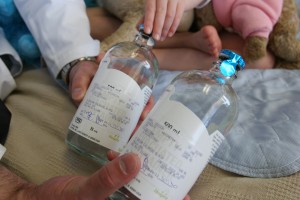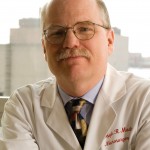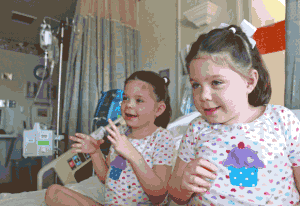
The twins' first cyclodextrin infusion bottles. Could this Febreze ingredient halt damage to their brains caused by Niemann-Pick Type C?
“Guess what just happened this afternoon?” It was late September, and Chris Hempel had just received an amazing communication from the Food and Drug Administration, and I got to be among the first to know. She’s not a doc, and not a researcher (in the usual sense), but a Mom out to save the lives and brain function of her identical twin girls. She is a force of nature powering a very small corner of translational research.
I first met Chris in person last spring, just as a Wall Street Journal article appeared featuring her story about seeking cures for orphan diseases. She was visiting Children’s Hospital Boston looking for a neurosurgical approach for a genetic condition—for which neurosurgery had never previously been considered. My chief, Dr. Mike Scott, referred her to me.
Chris is an impressive person to meet. She carried a camera, not to take pictures but to show me what she’d just seen at MIT: neurons derived from induced pluripotent stem cells (iPS cells) made from her daughters’ own skin. (As George Daley pointed out in a recent post, cultured patient-specific iPS cells are a good platform for testing potential treatments.)
The Hempel family story has been told in many media accounts, and is beautifully illustrated on the website addiandcassi.com. Addison and Cassidy, now almost 7 years old, were born with a genetic cholesterol condition called Niemann-Pick Type C (NPC), which results in cellular changes reminiscent of Alzheimer’s disease. Devastating problems with metabolism of cholesterol cause tissues to build up residues of cholesterol, and the brain to gradually deteriorate. There is no approved treatment or cure. Since Addi and Cassi’s diagnosis, in October 2007, Chris and her husband have been determined to change that.
Chris had found laboratory studies suggesting that a nontoxic, seven-ring sugar molecule called cyclodextrin, the active ingredient in Febreze air freshener, may help treat this fatal disorder. The compound was showing great promise in the animal models of Niemann Pick Type C. With the help of Dr. Caroline Hastings, a hematologist at Oakland Children’s, the Hempels convinced the peer reviewers and the FDA to allow treatment of the twins with cyclodextrin by vein.
For the past 18 months, the twins have been receiving cyclodextrin infusions directly into their bloodstream to try and halt disease progression. Unfortunately, while the IV infusions improved the cholesterol buildup in other organs, it did not improve the girls’ neurological status. Experiments done at King’s College in London by Dr. David Begley, funded by the Hempels and another family, showed that cyclodextrin would have to be given on the brain side of the blood-brain barrier to be effective.
Chris approached me with practical questions about ways to deliver cyclodextrin directly into the cerebrospinal fluid (CSF), allowing access to the brain. Usually this form of delivery is reserved for drugs that are well known, and extensive testing is required before such treatment. But if the normal criteria were used, we would never have an answer—certainly never in time for Cassi and Addi.
Chris and I discussed how the blood-brain barrier works, how catheters could be used in the testing, including temporary tubes placed into the brain and the fluid spaces around the spine, and how these catheters could be converted to more permanent pumps.
I emphasized that the surgery to place the catheters and pumps would be the easy part. The difficult part would be planning the escalation of doses and establishing a process for monitoring the effects—both positive and negative. Unlike our normal practices for starting a new clinical innovation, this has to work without extensive animal data before the first attempt to treat, and it has to work right the first time.
One approach would be to start with very low doses and follow Addi and Cassi for “surrogate outcomes,” that is, possible subtle improvements on MRI scans that would indicate we were actually having an effect. The girls would need close monitoring for dangerous side effects, especially during dose increases. And with incomplete preclinical data, we’d have to fly without instruments, simply responding to what happens.
I talked to a number of neurologists about how this might be done. Dr. Scott Pomeroy asked a team of neurologists and a geneticist to consider this closely: Basil Darras, Irina Anselm and Gerry Berry.
A big concern was whether the FDA would ever allow treatment to be given into the CSF at all, without huge preclinical studies. To be honest, we did not think it was possible, but Chris was determined to pull a protocol together. Without treatment, the situation seemed hopeless. With treatment—even if extremely risky—there might be hope.
This brings us to the exciting email from Chris: In September 2010, the FDA approved an experimental trial of direct CSF delivery of cyclodextrin into the twins. Over the past month, Addi and Cassi have received two injections of cyclodextrin via lumbar puncture and have been monitored closely at Oakland Children’s. The twins will have four more such treatments, and if all goes well, decisions will need to be made on how to deliver cyclodextrin chronically.
Chris is still consulting with me about what pump and catheters could be used for chronic delivery. We have discussed the idea of using a Medtronic SynchroMed pump off-label and how this could work. There are still many details to work out and more FDA approvals needed.
This is an extreme example of translational research, and young investigators interested in such research will find this path only rarely. The business, regulatory, and practice implications of this therapy, if it works, would need to be worked out.
And perhaps it will not work. It is important to remember that enthusiasm and good wishes do not produce positive scientific or clinical outcomes. But that is not the point.
The point is that we are now witnesses to a dramatic and exciting struggle to save the lives of two small girls. We don’t know how it will turn out. But the Hempel family has been sprinting along on a very narrow bridge high in the sky, undeterred by fear. We salute them, stand with them, and offer our best hope and any help as needed.
 Joseph Madsen, MD, is director of the Epilepsy Surgery Program in the Department of Neurosurgery at Children’s Hospital Boston, and director of the Neurodynamics Laboratory.
Joseph Madsen, MD, is director of the Epilepsy Surgery Program in the Department of Neurosurgery at Children’s Hospital Boston, and director of the Neurodynamics Laboratory.










